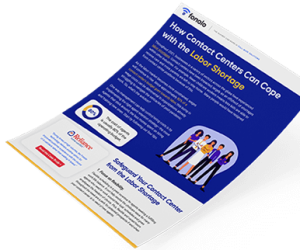Agents are the key to a successful call center—that’s no secret. But it takes more than hiring the right individuals to reach your goals.
People management is a big part of running a successful call center, including managing employee absences, both scheduled and unscheduled. While it’s normal for agents to take an occasional sick or personal day, extended time away from work can directly affect your KPIs and other performance metrics.
If unplanned absences are starting to get the best of your team, it’s time to act. Read on as we explore tried and true tactics for lowering absence rates and improving overall performance for your call center.
A Quick Introduction to Absenteeism
Absenteeism, or absence rate, is a percentage figure that represents how much unapproved time agents are spending away from work. These might be last-minute absences, or time spent away from their desk during their shift. Some examples of unplanned absences include:
- Sick leave
- Personal days
- Extended breaks at work
- Other unexplained absences
To be clear, absence rate does not include approved or mandatory time off, like vacation days or jury duty. Your absence rate will never hit zero—after all, your agents will have things come up in their lives suddenly that will require accommodation from management. The kind of absenteeism that needs addressing is excessive, unplanned time away that has a negative impact on the workplace.
According to CSG, the global average rate for absenteeism is 5%. This is a good benchmark to work with if you’re measuring this metric for the first time. If your absence rate exceeds the global average, you should address this metric immediately.
How Does Absenteeism Impact the Call Center?
Before you start thinking of this metric as a glorified attendance tracker, you’ll want to consider how it affects your call center performance. Remember what we said about agents being the key to a successful call center? If they aren’t present when scheduled, your team will quickly find itself short-staffed and overwhelmed with calls.
Here are the key metrics directly affected by absence rate:
- Cost of operation
- Staffing and scheduling
- Customer satisfaction (CSat)
- First call resolution (FCR)
- Abandonment rate
- Agent satisfaction and attrition
An agent or two calling in sick shouldn’t topple your call center performance metrics, but when unexplained absences become more frequent, you may find yourself on a slippery downward slope. That’s precisely why it’s important to keep an eye on your absence rate and act if it begins to rise.
6 Tips to Control Call Center Absenteeism
We’ve explored the what and why of absenteeism in the call center. Now comes the how—as in “how to remedy a high absence rate.”
There are many factors that contribute to absenteeism, and while some may be out of management’s control, there are plenty that can be addressed. Here are a few examples:
- Work stress or burnout
- Insufficient support at work
- Frequent scheduling issues
- Poor culture fit
- Negative work atmosphere
The good news is you aren’t the first person to face these challenges. These tried and tested techniques will get your contact center moving in the right direction.
1. Update your attendance policy.
A transparent and clear attendance policy is the first step to formalizing your absenteeism standards. Ensure all agents and employees are clear on attendance expectations and let them ask questions.
If your contact center has shifted to hybrid or remote work in the past few years, reviewing this policy with staff is even more critical. Ensure that these policies are relevant and make sense with your current operation.
2. Assess your work environment.
Take a good look at your contact center workspace. Is it an environment where agents will be able to stay focused and motivated in their daily work? If your space is drab and dreary, it may be worth the investment to give it a makeover.
Ask your agents to recommend changes to their work environment. Simple things like better lighting, air circulation, or even a fresh coat of paint can go a long way to creating a productive setting for your contact center.
3. Offer immediate feedback.
Have you noticed certain agents taking more than their allotted break time? You may be tempted to hold onto your feedback until their next performance review. However, you risk their behavior becoming a habit—or worse, they may begin to influence other employees.
Offering immediate feedback doesn’t need to be formal. Take the agent aside and offer a gentle reminder of your attendance and absenteeism policy and give them a chance to ask any questions they may have.
4. Supply helpful tools and technology.
If your call center agents don’t have the tools they need to succeed in their daily work, they may feel inclined to avoid it, which can lead to higher absence rates. It’s in your best interest to ask them what they need to do their job smoothly without unnecessary frustration.
High call volumes are one of the biggest sources of stress for call center agents. Call center solutions like Voice Call-Backs and Web Call-Backs (formerly Visual IVR) help keep call volumes under control, so agents can worry less about customers on hold and focus on providing excellent service instead.
DID YOU KNOW?
Call-back technology eliminates the need for hold-time, keeping your call queues manageable and your agents frustration-free!
5. Incentivize good attendance.
It’s one thing to set expectations around attendance, but another to motivate your team to follow them. That’s where incentives come in. By offering a prize—for example, a free vacation day or a cash bonus—your agents will be more willing to comply, and even go the extra mile to win!
6. Conduct return-to-work interviews.
For agents returning from extended leave, it’s helpful to conduct a return-to-work interview. This gives you the chance to document any reasons behind the absence and come up with ways to support their transition back to work.


